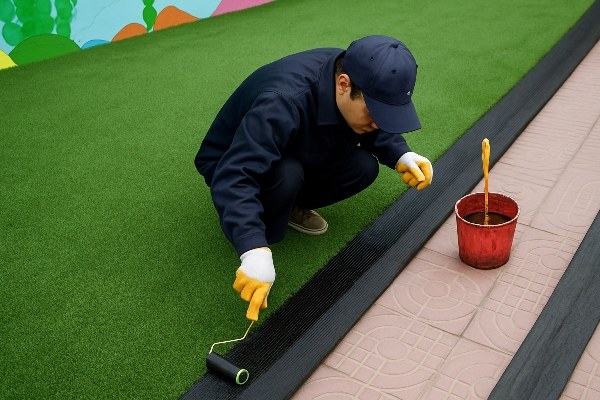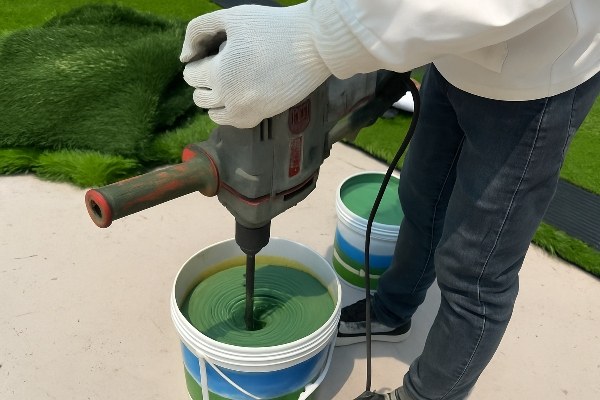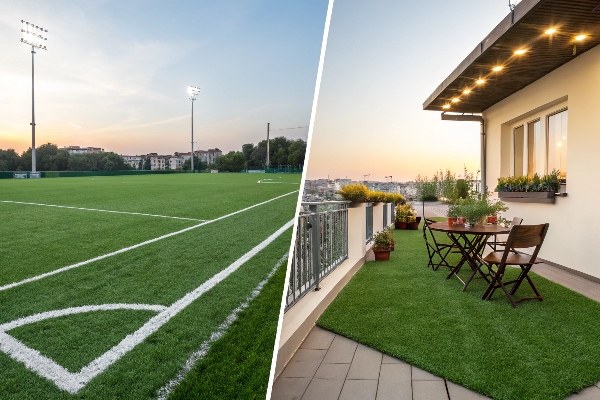Struggling with lifting turf seams? Worried your adhesive won’t hold up in bad weather? Choosing the wrong glue can ruin a perfect installation and cost you time and money.
The best choice depends on your project. One-component adhesive is easy to use for small repairs and dry conditions. Two-component adhesive offers superior strength and weather resistance, making it ideal for professional installations and demanding environments.

Choosing the right adhesive is one of the most critical steps in any artificial grass installation. It’s the difference between a seam that disappears and one that becomes a problem later. I’ve seen both amazing successes and costly failures, and it often comes down to the glue. Let’s break down the options so you can make the right choice for your project and ensure it lasts for years.
What is a One-Component Adhesive and When Should You Use It?
Need a quick, simple fix for a turf seam? Confused by mixing ratios and complicated instructions? One-component glues offer a straightforward solution for easy jobs.
A one-component adhesive is a pre-mixed, moisture-curing glue. You use it straight from the cartridge. It’s best for small repairs, DIY projects, indoor applications, or areas with low foot traffic where conditions are consistently dry.

A one-component adhesive1 is as simple as it gets. It comes ready to use in a tube or cartridge. The chemical magic happens when the adhesive is exposed to moisture in the air. This process, called moisture curing, slowly hardens the glue to create a bond.
I once consulted on a small indoor putting green project for a client. He was doing it himself and was nervous about mixing chemicals. I recommended a good quality one-component polyurethane adhesive. It was the perfect solution. He applied it easily, and since it was indoors with no rain or extreme temperatures, it cured perfectly and has held up for years. This is where this type of adhesive truly shines.
Key Characteristics
One-component adhesives are defined by their simplicity. However, this simplicity comes with trade-offs.
- Ease of Use: There is no mixing involved. You just open the container and apply it. This reduces the chance of human error.
- Curing Time: They generally take longer to cure fully, sometimes up to 24-48 hours, depending on humidity and temperature. Low humidity can slow the process down significantly.
- Bond Strength: The final bond is generally not as strong as a two-component system. It’s strong enough for certain applications but might not withstand the heavy stress of a sports field.
When is it the Right Choice?
| Application Scenario | Why It Works Well |
|---|---|
| Small Repairs | Perfect for patching a small tear or re-gluing a minor lifted edge. |
| DIY Home Projects | Its simplicity makes it ideal for homeowners without professional tools. |
| Indoor Installations | The controlled environment protects it from rain and extreme temperatures. |
| Low-Traffic Areas | Suitable for decorative lawns that won’t see heavy foot traffic. |
How Does a Two-Component Adhesive Work for Turf Installation?
Worried your turf won’t withstand heavy use or extreme weather? Are standard glues failing you? A stronger, more reliable bond is essential for professional results that last.
A two-component adhesive2 consists of a resin and a hardener that you must mix together before use. This chemical reaction creates an incredibly strong, waterproof bond. It is the professional standard for sports fields and high-traffic areas.

Two-component adhesives are the workhorses of the professional turf industry. They come in two separate containers: Part A (the resin) and Part B (the hardener). When you mix them in the correct ratio, a chemical reaction starts. This reaction generates heat and creates a cross-linked polymer structure that is far stronger and more durable than any one-part adhesive.
I learned the importance of this process early in my career. We were installing a football field, and a new team member rushed the adhesive mixing. The ratio was off. Days later, the seam felt weak, and we had to cut it out and redo it. That costly mistake taught me a valuable lesson: precision is everything with two-component glues. Measure twice, mix once, and always follow the manufacturer’s instructions. When done right, the result is a seam that is just as strong as the turf itself.
The Science of Strength
The power of this adhesive comes from its chemistry.
- Controlled Reaction: Unlike moisture-curing glue3s, the curing process is a controlled chemical reaction. This means it will cure reliably, even in low humidity.
- Pot Life: Once mixed, you have a limited time to use the adhesive before it starts to harden in the bucket. This is called "pot life" and is usually between 30 to 60 minutes.
- Superior Bond: The final bond is extremely strong, flexible, and resistant to water, heat, and cold. This is why it’s the only choice for professional sports applications where seams are under constant stress.
Which Factors Should You Consider When Choosing an Artificial Grass Adhesive?
Overwhelmed by adhesive choices? Unsure what matters most for your specific project? Choosing incorrectly can lead to installation failure, callbacks, and wasted money.
Consider the project size, climate, and planned usage. For large, outdoor, high-traffic areas like sports fields, a two-component adhesive is essential. For small, indoor, or dry, low-traffic repairs, a one-component adhesive is often sufficient.

The decision between one-component and two-component adhesive is not just about good versus better; it’s about the right tool for the right job. As an engineer, I always analyze the project requirements before recommending a product. A mistake here can compromise the entire installation. For my clients who are business owners, making the right choice upfront saves money and protects their reputation. You need to think about the specific demands of your project. Let’s compare them across the most important factors you will face.
Head-to-Head Comparison
Making a smart decision means weighing the pros and cons for your specific situation. This table breaks down the key considerations I review with my clients.
| Factor | One-Component Adhesive | Two-Component Adhesive | My Recommendation |
|---|---|---|---|
| Project Size | Best for small repairs or projects under 15 sq meters. | Ideal for any size, but essential for large installations. | Go with two-component for anything larger than a small patio. |
| Installer Skill | Very DIY-friendly. No mixing required. | Requires precision and experience to mix correctly. | If you’re new to installation, practice mixing small batches first. |
| Foot Traffic | Suitable for low-traffic, decorative areas. | Necessary for high-traffic areas like playgrounds and sports fields. | For any area where people will run and play, always use two-component. |
| Climate | Needs mild temperatures and humidity to cure properly. | Cures reliably in a wider range of temperatures and humidities. | In wet or very hot/cold climates, two-component is the only choice. |
| Curing Speed | Slow, often 24+ hours. Dependent on weather. | Fast and predictable, usually cures within a few hours. | For professional jobs where time is money, two-component is more efficient. |
| Cost | Lower upfront cost per tube, but less coverage. | Higher upfront cost per kit, but better coverage and value. | Think long-term. The durability of two-component adhesive is worth the cost. |
Conclusion
Choosing the right adhesive is crucial for a lasting installation. One-component glue is great for small, simple jobs, while two-component provides the professional strength needed for most projects.
-
Explore this link to understand the benefits and applications of one-component adhesives for your projects. ↩
-
Learn about two-component adhesives and their superior bonding capabilities for demanding applications. ↩
-
Learn about the science behind moisture-curing glues and their advantages in various applications. ↩
_画板-1.png)
_画板-1.png)